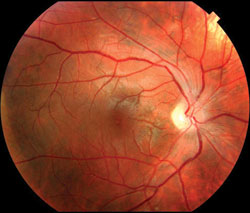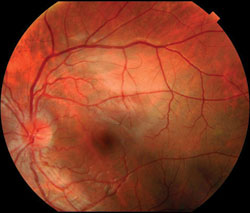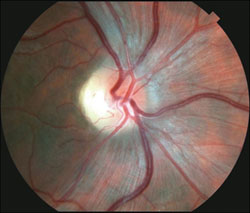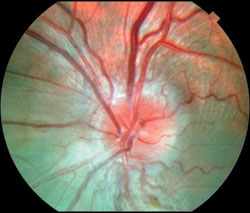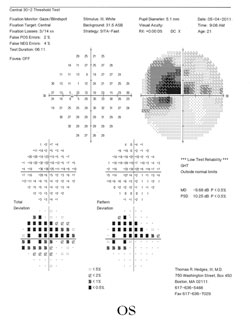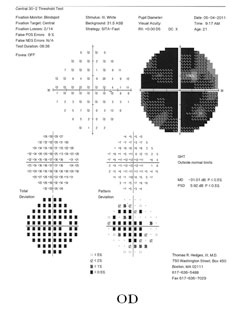Man has trouble reading a college basketball scoreboard
There was temporal optic nerve pallor with maculopapillary retinal nerve fiber layer loss in the right eye and a diffusely swollen optic nerve with peripapillary telangiectatic vessels in the left eye.
 Catherine A. Cox |
 Jordana F. Goren |
A 21-year-old man presented to the New England Eye Center complaining of difficulty reading. One month prior, he had noted trouble reading a college basketball scoreboard with his right eye. Vision in his right eye progressively worsened over the course of 2 weeks, during which time he noted onset of blurred vision in his left eye. He denied any headaches, paresthesias, flashes, floaters, eye pain or diplopia.
History
The patient’s ocular history was significant for a history of mild myopia, for which he wore corrective lenses. His medical history was unremarkable. He was a college student, worked part-time as a line cook, denied any tobacco use and reported drinking about 10 beers per week. His family history was notable for both a maternal uncle and a first cousin with low vision.
Examination
On examination, best corrected visual acuity was counting fingers in the right eye and 20/200 in the left eye. There was a relative afferent pupillary defect noted in the right eye. Extraocular movements were full, IOPs were 11 mm Hg and 13 mm Hg, and anterior segment examination was normal. Dilated fundus examination demonstrated temporal optic nerve pallor with maculopapillary retinal nerve fiber layer loss in the right eye and a diffusely swollen optic nerve with peripapillary telangiectatic vessels in the left eye (Figures 1a, 1b, 1c and 1d).
|
|
|
|
|
|
|
Figures 1a-1d. Fundus photography showing
temporal optic nerve pallor and maculopapillary retinal nerve fiber layer loss
in the right eye (1a and 1c), as well as a diffusely swollen optic nerve and
peripapillary telangiectatic vessels in the left eye (1b and 1d).
Images: Cox CA, Hedges
TR |
|
Hardy Rand and Rittler pseudoisochromatic plate testing showed absent color vision in the right eye and moderately diminished color vision in the left eye. Humphrey visual field testing was significant for patchy full-field defects in the right eye and a centrocecal scotoma in the left eye (Figures 2a and 2b). Optical coherence tomography of the retinal nerve fiber layer demonstrated temporal nerve fiber thinning in the right eye and a thickened nerve fiber layer in the left eye (Figure 3). Macular OCT scans did not show any subretinal fluid or other abnormalities.
|
|
|
|
Figures 2a and 2b. Humphrey visual field 30-2
testing revealing patchy full-field defects in the right eye (2b) and a
centrocecal scotoma in the left eye (2a). |
|
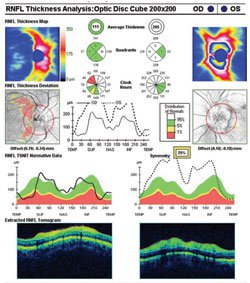 Figure 3. OCT showing temporal nerve fiber layer thinning in the right eye and a thickened nerve fiber layer in the left eye. Of note, the temporal nerve fiber layer in the right eye is thinner than the quadrant map indicates. A disruption in contour of the temporal nerve fiber layer is present on the normative data plot, indicating a software algorithm failure. |

What is your diagnosis?
Optic nerve changes
The differential diagnosis for a patient with bilateral optic nerve changes — atrophy and contralateral swelling — includes Leber’s hereditary optic neuropathy, autosomal dominant optic atrophy, nutritional deficiencies, toxic exposures, non-arteritic ischemic optic neuropathy, optic neuritis and, less commonly, compressive lesions presenting as Foster Kennedy syndrome.
Nutritional deficiencies may result from inadequate intake or absorption of folate and/or B-complex vitamins such as thiamine, riboflavin and B12 (cobalamin). Exposure to toxic substances or medications such as arsenic, carbon monoxide, cyanide, lead, methanol, ethambutol, isoniazid or amiodarone can also lead to optic neuropathy. Our patient reported a healthy diet, no systemic medications and no exposure to toxic substances. Of note, he did report above-average alcohol intake on a weekly basis. Non-arteritic ischemic optic neuropathy can also present with unilateral optic atrophy and contralateral optic nerve head swelling; however, the age of the patient and the degree of visual loss point away from this diagnosis.
The patient’s family history included a maternal uncle and a first cousin with low vision. These two male relatives had both experienced vision loss in their mid-20s, and each had been tested for the mitochondrial DNA mutations associated with Leber’s hereditary optic neuropathy (LHON). Of the three mutations available for testing, both relatives were found to be positive for the 11778 mutation. Based on our patient’s strong family history, relatively young age, time course of vision loss, and lack of other systemic or ocular symptoms, the most likely diagnosis was determined to be LHON.
Follow-up
To rule out treatable causes for vision loss, the patient was tested for vitamin B12 and folate deficiencies. Levels for both were found to be within normal limits. MRI of the brain and orbits was deferred due to high suspicion for LHON, particularly given his strong family history and typical presentation. Due to insurance issues, the patient was not able to undergo genetic testing for LHON-associated mitochondrial DNA mutations.
The patient was counseled on lifestyle changes, including avoiding excessive tobacco and alcohol intake, eating a balanced diet and decreasing stress in his life. He was started on idebenone, a synthetic CoQ10 analog, and informed that he would not pass this disease on, given that LHON is maternally inherited. Finally, information was provided to him for accessing services via the Commission for the Blind.
Discussion
The key presenting symptom of LHON is sequential, painless vision loss. Vision loss typically occurs first in one eye, followed by loss in the contralateral eye within days to weeks. The average interval between involvement of the first eye and the second eye is 2 months. Final visual acuity can vary from 20/25 to hand motions; however, the nadir of visual acuity is expected to occur within 4 to 6 weeks of onset.
Given the sequential involvement of each eye, funduscopic examination may reveal a two-stage process. In the early phase, peripapillary microangiopathy and nerve fiber layer swelling may be observed. In the late phase, temporal disc pallor with nerve fiber layer loss develops. Interestingly, the optic disc may appear normal in up to 20% of patients, but when optic nerve changes are observed, the papillomacular bundle is preferentially affected. Ancillary testing typically reveals centrocecal scotomas and diminished color vision in each affected eye.
The onset of LHON often occurs in the second decade; however, isolated cases of LHON have been reported as late as the eighth decade. Critical stages in a patient’s domestic or professional life, such as starting college or going through a divorce, have also been thought to play a role. It has been speculated that poor nutrition, stress, and excessive alcohol or tobacco use during these critical stages may contribute to the precipitation of disease in genetically susceptible individuals.
Three mitochondrial DNA mutations — 11778, 14484 and 3460 — have been linked to LHON. Fifty percent of LHON cases are associated with the 11778 mutation, which carries the least favorable prognosis. The 14484 mutation has been associated with occasional late improvements in visual acuity. Because LHON is a mitochondrial disease, it follows a strict maternal inheritance pattern. However, visual impairments present with incomplete penetrance: Only 50% of affected males and 10% of female carriers develop optic neuropathy.
The pathogenesis of LHON is due to impaired ability of mitochondria to produce adenosine triphosphate (ATP), which is important for powering cell function. Decreased ATP levels also lead to impaired axonal transport of mitochondria to the macula, an area of high-energy requirements. The papillomacular nerve fiber layer bundle is preferentially affected in LHON, and this is thought to be due to its need for increased rates of firing from the macula, as well as its anatomically narrow caliber axons.
Treatment of LHON should include counseling on stress reduction, avoidance of excessive tobacco and alcohol consumption, and good nutrition. Idebenone, a synthetic coenzyme Q10 analog, provides a theoretical benefit by helping to increase ATP production via an alternate pathway as well as scavenging free radicals. No clear beneficial role of idebenone has been proven, however, and the use of this medication for treatment of LHON is optional.
Interesting prospects in gene therapy are currently under investigation. Treatment of LHON by intravitreal injection of adeno-associated virus, genetically engineered to target the specific mitochondrial DNA mutation present in each patient, is being studied in a phase 2 clinical trial. This treatment strategy might eventually be used to improve or halt optic nerve changes in affected patients, as well as to potentially prevent vision loss in known carriers.
References:
- Hedges TR 3rd, Hirano M, Tucker K, Caballero B. Epidemic optic and peripheral neuropathy in Cuba: a unique geopolitical public health problem. Surv Ophthalmol. 1997;41(4):341-353.
- Hudson G, Yu-Wai-Man P, Griffiths PG, et al. Variation in OPA1 does not explain the incomplete penetrance of Leber hereditary optic neuropathy. Mol Vis. 2010;16:2760-2764.
- Ikeda A, Ikeda T, Ikeda N, Kawakami Y, Mimura O. Leber’s hereditary optic neuropathy precipitated by ethambutol. Jpn J Ophthalmol. 2006;50(3):280-283.
- Kerrison JB, Miller NR, Hsu F, et al. A case-control study of tobacco and alcohol consumption in Leber hereditary optic neuropathy. Am J Ophthalmol. 2000;130(6):803-812.
- Lam BL, Feuer WJ, Abukhalil F, Porciatti V, Hauswirth WW, Guy J. Leber hereditary optic neuropathy gene therapy clinical trial recruitment: year 1. Arch Ophthalmol. 2010;128(9):1129-1135.
- Man PY, Turnbull DM, Chinnery PF. Leber hereditary optic neuropathy. J Med Genet. 2002;39(3):162-169.
- McFarland R, Taylor RW, Turnbull DM. A neurological perspective on mitochondrial disease. Lancet Neurol. 2010;9(8):829-40.
- Yanoff M, Duker JS. Ophthalmology. 3rd ed. Philadelphia: Elsevier; 2009:976-979.
- Catherine A. Cox, MD, and Thomas R. Hedges III, MD, can be reached at New England Eye Center, Tufts University School of Medicine, 800 Washington St., Box 450, Boston, MA 02111; 617-636-4219; fax: 617-636-4866; website: www.neec.com.
- Edited by Catherine A. Cox, MD, and Jordana F. Goren MD, MS. Drs. Cox and Goren can be reached at New England Eye Center, Tufts University School of Medicine, 800 Washington St., Box 450, Boston, MA 02111; 617-636-4219; fax: 617-636-4866; website: www.neec.com.

